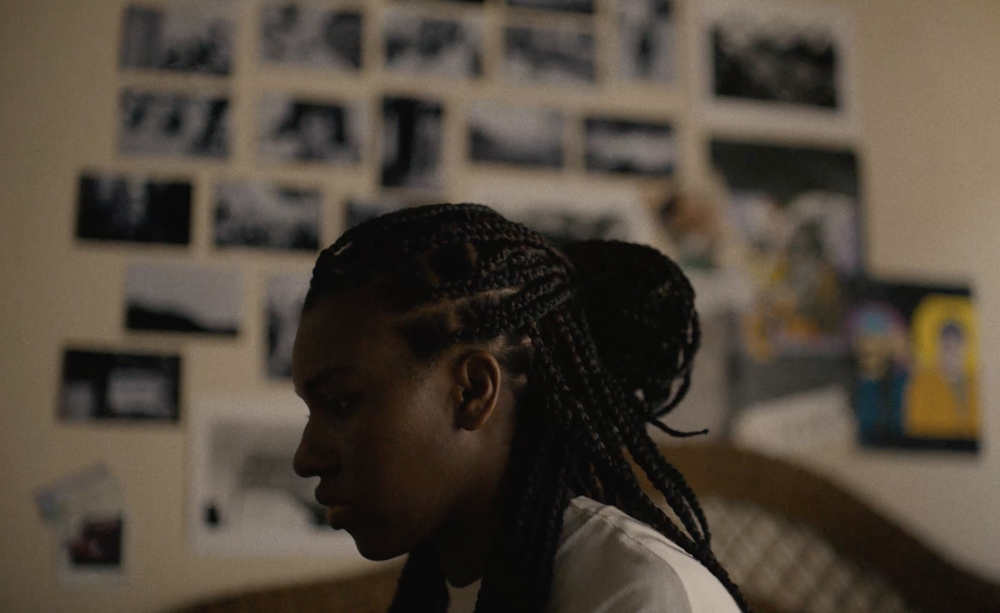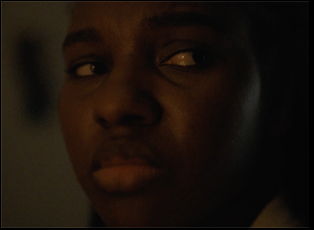Tanisha (Mikayla Lashae Bartholomew) is already suffering one incalculable loss when she learns of another in “Dear Mama,” stopped in her tracks as a news report comes on announcing the death of Tupac Shakur. She can be seen packing her things after her father Nate (Garland Scott) has decided he can’t spend another minute in the house they shared with her mother Rene when she is no longer there with them, but even her distraction of putting on headphones and getting lost in music is tainted when she has to process the fact that everyone she turned to for comfort is gone, or seems like it when Nate has gone completely quiet in his grief.
Part of what makes the dramatic short directed by Winter Dunn and written by Charmaine Cleveland so arresting on its own is how this pain manifests itself into space, the camera’s focus sharpening when it feels acute for Tanisha and the world around her growing more abstract when she doesn’t know what to make of what she’s feeling, aware of the parameters of a house she’s spent most of her life in, but now feels completely lost inside. A reckoning is due when Nate is ready to move on, but his teenage daughter isn’t, and before the two can even engage with one another you can see the struggle within themselves to figure out the right course of action, their love for each other actually preventing a conversation from occurring when they want to be careful not to inadvertently touch on a raw nerve.
Somewhat fittingly, it took a group of virtual strangers to come together to so sensitively observe such intimate family dynamics as “Dear Mama” emerges from the talent incubator Project Involve from Film Independent to showcase strong new filmmakers in all departments. the film does that and then some, apt to pack a punch when it premieres this week at SXSW and on the eve of its premiere, Dunn, who’s already enjoyed success at the festival as a producer on the 2019 breakout “Jezebel,” spoke about getting comfy in the director’s chair, shepherding a production that required great care during the pandemic and employed all of the many skills she’s accumulated in an already impressive career as well as finding such strong actors and honing such a distinctive visual language for the film.
All of the core team of filmmakers were a part of Film Independent’s Project Involve fellowship. We were the 2021 class coming in right after COVID broke, and the fellowship was virtual and everyone was is isolation, which was an insane experience, as you can imagine, but a really, really amazing and incredible one. We were having conversations with different industry professionals and eventually developing all our preproduction and coordinating.
Charmaine [Cleveland, the screenwriter] came in with a very exciting core premise, which was to live with a family in the mid ‘90s on the day that Tupac’s death was announced. I thought that was really fresh and I was excited coming into a period piece and we spent months developing this idea. In those conversations, we all realized there was something about that grief piece that really tied the pain of losing a cultural icon like Tupac, but then also ties us back to this family and what they’re trying to navigate as far as themselves — how the character of Tanisha is trying to come to terms with her losing her mother and not even being able to speak to her father about it. It was a long development process, but it was really great that I got to do that in this safe space, which is the Film Independent program.
This is jumping ahead, but the movement seemed so connected to the emotion of this. Were you thinking about blocking the actors from the script stage?
The blocking was paramount. I have a dance background, so movement of body and camera is something I pay attention to even when we are on script. Once we got into the preproduction space, getting out looking at locations via my DP Mike [Maliwanag], we were constantly thinking what spaces have the best lines and [where] am I able to utilize this character and really show her movement and how it can connect back to her emotional state. I didn’t want to find a house that was one big room and there was nowhere for us to go with the camera.
I’m really happy with the location we found. We looked at so many houses for this film, places that would’ve been much easier to book at a different time and folks are like, “Hey, I don’t necessarily want folks in our house right now.” It’s COVID, so my producer and myself really hit the ground in our research, trying to find this house. [The one we used was] the last place we looked at, and it was perfect except for one production design element. There was a big wall in that dining room that had a really modern, very 2000s print, so we had to come in and re-wallpaper that entire wall to make it feel a bit more grounded in the color palette of the film and in the time.
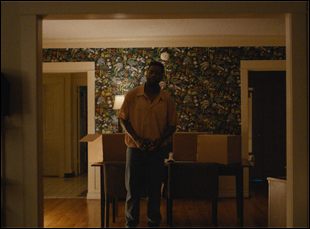
It came first from a place of necessity because that original wallpaper you wouldn’t find in ‘96, so I immediately called our production designer [Coleen Chan] and she hit the ground, picking so many options. It was really incredible, but there’s something about that greenery that’s hard to put into words, but I saw it and went, “Yes. Yes.” Throughout this film, we weren’t afraid to play with shadow, bringing the color down and grounded and there was something about that really beautiful green that did connect us back to the film in a way that wasn’t so obvious. I thought that was an exciting choice, so I’m glad that it played.
Generally, what was it like getting that period detail right for the film? That X shirt Tanisha wears took me right back.
Research, research, research. I was very young when Tupac died, but even being young, I remember it vividly and my uncle talking to my mom about it. I came from a very religious home, so it wasn’t like we were listening to hip-hop casually and I felt very connected to Tanisha, sneaking my headphones in my room and listening to Eminem or Tupac, and just zoned out, trying to still my own thoughts before going back out into public spaces in our home, so that really connected with me. I could only imagine what that had been like in 1996 when this huge cultural icon passed away and then all of your parent figures, no one is supporting the music. It’s like the music is keeping me afloat and the one place I find peace and no one’s able to see that except your friends or your cousins. So we researched that time heavily and found so much footage of people talking during the week of his death about the heartbreak they felt and how visceral it was. It was like they had lost a member of their family or a friend and I thought, “Okay, if we can connect people with what they felt when we lost Tupac and connect that to what it must feel to actually lose a member of your family, then we might do something right.”
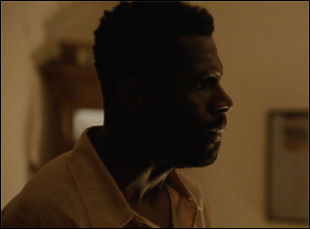
This was not going to work if we didn’t find the right actors to drive this home. Mikayla was phenomenal. She had just come off of doing “King Richard” and she’s everywhere doing theater in New York and San Diego, so I connected with our casting director and told her, “Hey, it’s a young character, but I’m not really interested in someone who plays the youth of it all or who’s like, “I’m young and I’m fab!” This is a grounded girl who understands what’s going on in her household probably more than her father does and she’s not given the right to have that open conversation.” And our casting director Shyree [Mezick] immediately said, “I have someone, she is really phenomenal, but we didn’t want to have to ask her to audition because she had just been working so much, so we saw so many incredibly talented actresses for that role, but the moment we talked to Mikayla about the work, it was really clear that she knew how to ground this girl. I felt that she would be able to play out the emotional state without language. So much of Tanisha is in silence, I needed to know how it would read in her face and how she carried herself.
I felt very safe when we found Mikayla and it was similar with Garland. We were looking at so many known actors, trying to figure out what was the right fit with this girl and he came in with this real explosive energy and so ready to adjust and play and do the thing, it was like it was kind of kismet. I knew when we get them in a room together and we sit down at a table and work through this script, they’re just going to find more things and it would even surprise me that they did many times. I also have an acting background and I look at my actors as collaborators, so I come in with a really clear vision of what the story is and how we’re going to shoot this, but I am open to an actor saying, “Look, I’ve done the work, I know this person. Can I try something?” That is so exciting to me and both of these actors were willing to play and really throw stuff out there. Laying the foundation in our table work and our rehearsals so that when we got there, we could really embrace the play and what felt needed in the moment.
It feels like you’re dancing along with them in terms of not only the camera movement, but how the focus adjusts throughout. What was it like figuring out the camera language for this?
Yeah, my DP Mike is really a beautiful collaborator and we sat down quite a bit before we were even looking at cameras. We were watching films for reference and images together, and I told him I really want to embrace imperfect frames and I thought it would be really beautiful if the film had been shown on a camera that existed in the ‘90s. I really wanted to embrace that warm sepia tone and [Mike] took that and just really ran with it. We had a really detailed shotlist because we’re both planners, but we’re both the type to show up on set and be like, “Okay, toss the plan because this is what’s happening in the room.” [laughs] There were many moments where we shot just like we planned and then he really does have a documentary approach where you can put him in a room with his team and he made our camera feel like you’re in the house with them in the discomfort of that environment, but I hope you feel that to the end where we settle the camera and everyone gets to breathe a bit.
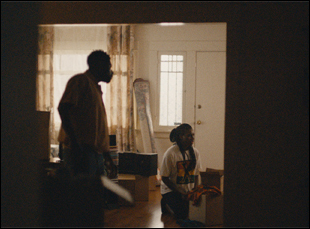
Yeah, I am very grateful to have such an expansive creative background. It all influences my directing. Dance and my experience in creating an emotional response through the body is 100 percent now prevalent in my work, and I love connecting with actors and building out scenes. I was also directing theater, starting in Chicago years ago, so the goal of all these things is to make me a smarter director because directing is definitely the thing. The moment I stepped into that role, I thought, “this is it.” I love this work. i love the gritty sitting down with my team and digging through the text and finding what makes this thing tick and finding the collaborators to bring it to life.
What’s it like getting to the finish line with this?
It is the most incredible feeling. Most of our prep was on Zoom and a lot of our post-production. It’s tough to make a film when you’re not in the room with your team, so to now be able to premiere the film at SXSW, which is such an honor, and also celebrate it with my team in person physically for the first time because we’re all in different parts of the country, it is truly a magical feeling.
“Dear Mama…” will screen at SXSW as part of Shorts Program 2 on March 12th at 2:15 pm at the Alamo Lamar B and March 16th at 12:15 pm at the Alamo Lamar E. It will also be available virtually with a SXSW Online badge beginning March 13th.




